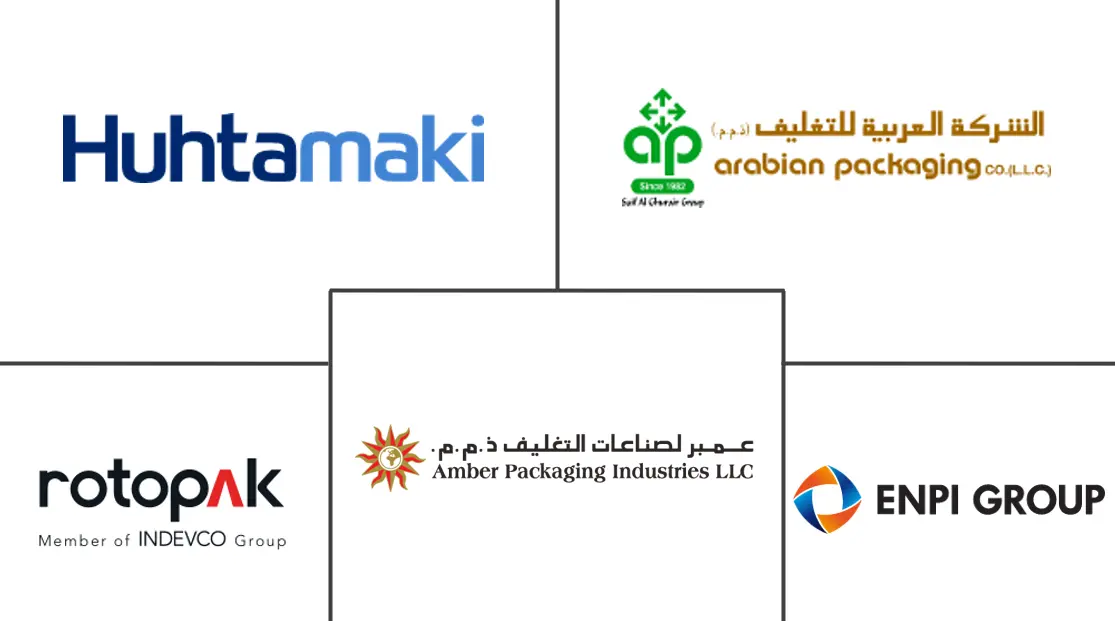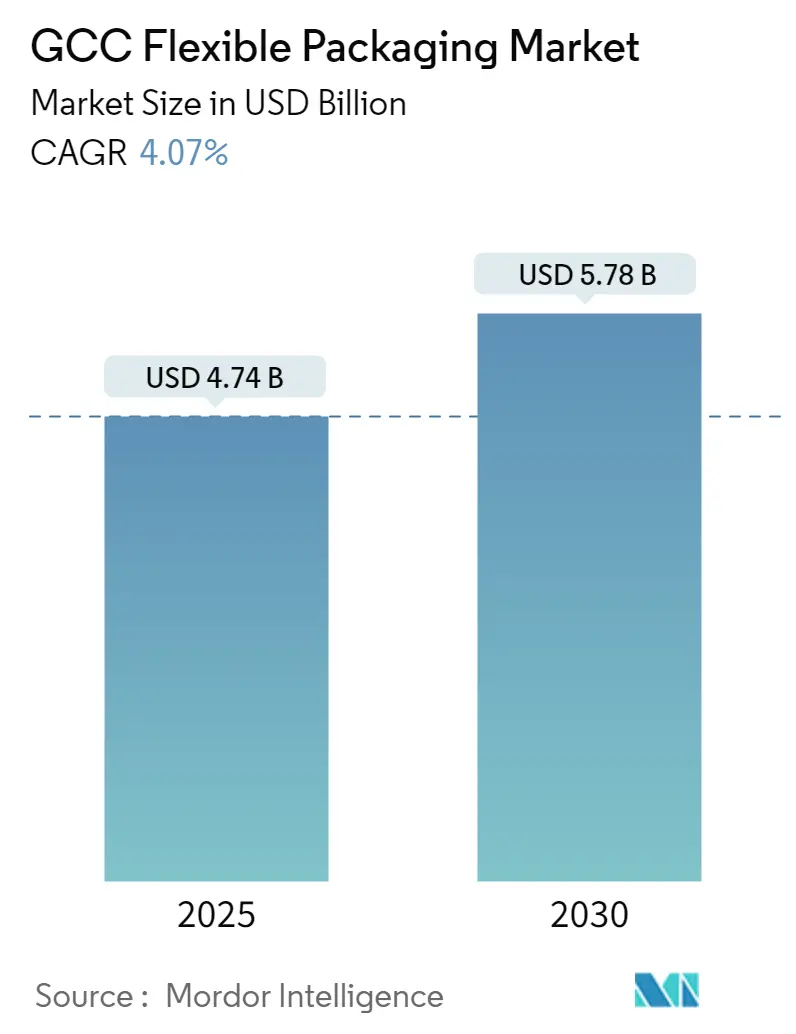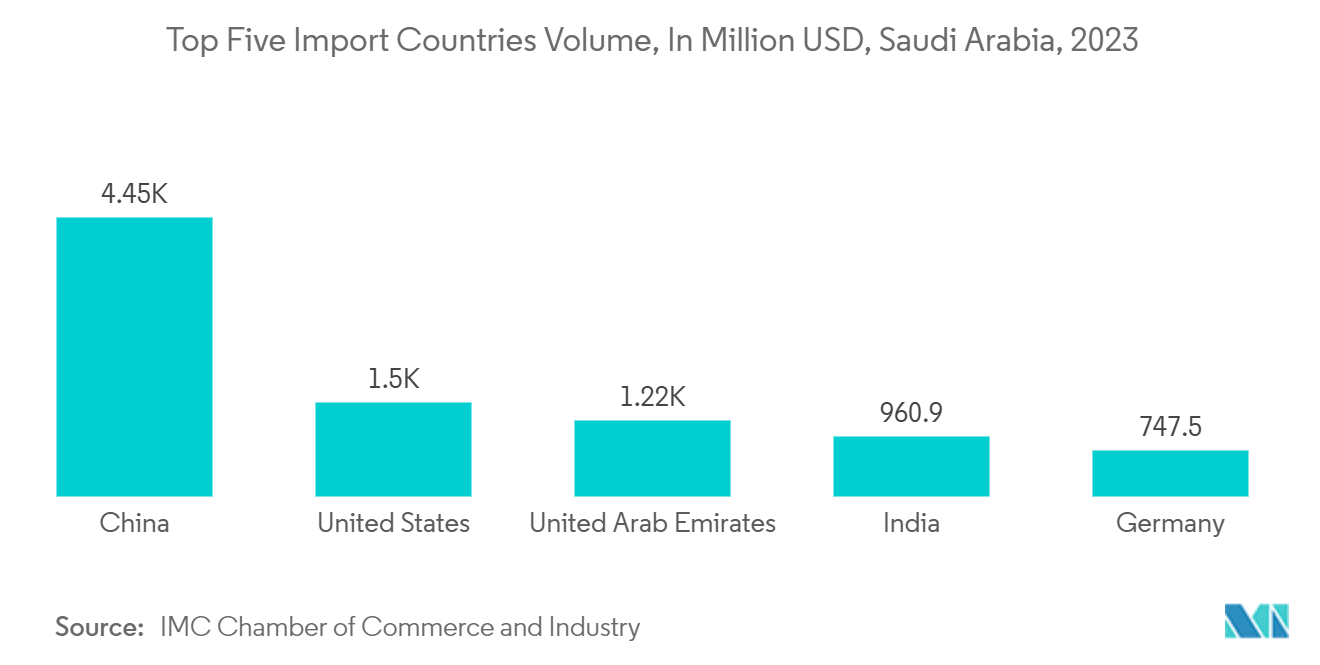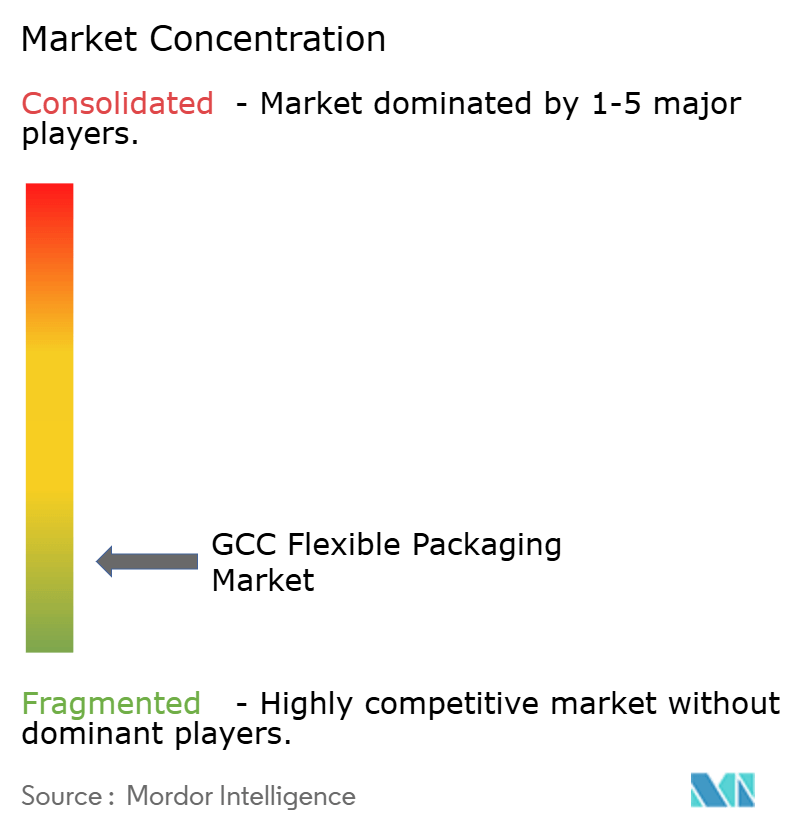GCC Flexible Packaging Market Analysis
The GCC Flexible Packaging Market size is worth USD 4.74 Billion in 2025, growing at an 4.07% CAGR and is forecast to hit USD 5.78 Billion by 2030.
The GCC region is poised for economic expansion, with rising disposable incomes fueling demand in key end-user sectors like food and beverages, pharmaceuticals, and e-commerce, particularly in flexible packaging.
- Within the Middle East, the GCC stands out as a pivotal market for packaging. The surge in food packaging demand, propelled by heightened food consumption due to escalating tourism and urbanization in the UAE and Saudi Arabia, underscores this market's growth trajectory. Notably, the UAE witnessed a 40% surge in international visitor spending in 2023, as the World Travel and Tourism Council reported, further bolstering the packaging market.
- The region's appetite for consumer staples, including food, beverages, and pharmaceuticals, is rising, driving the demand for flexible packaging. This demand is further fueled by a preference for convenient, on-the-go packaging solutions, especially as urbanization in the region amplifies the call for sustainable and convenient packaging. Embracing flexible packaging aligns with evolving lifestyles and capitalizes on the convenience it offers, especially in processed food.
- Urbanization and shifting demographics are reshaping the packaging landscape, with consumer behaviors and trends playing a pivotal role. The packaging sector is witnessing an expansion, influenced by these changing dynamics, as well as shifts in income patterns and disposable incomes across various sectors.
- The demand for flexible packaging products is driven by millennial consumers who prefer single-serving and on-the-go food and beverages. The durability, portability, and lightweight properties of flexible packaging make it a preferred choice for product packaging. These factors are expected to increase the demand for flexible packaging in the GCC's food and beverage industry.
- Despite the optimistic outlook, environmental concerns, especially around plastic recycling, pose a challenge. The region grapples with a shortage of plastic recycling facilities, hampering the proper recycling and safe disposal of flexible packaging products.
GCC Flexible Packaging Market Trends
Food Industry to be the Largest End User Industry
- Flexible packaging, encompassing films, pouches, aluminum lids, and paper bags, is a staple in the food industry, commonly used for products like smoothies, snacks, dairy, and confectionery. While often serving as primary packaging, it also finds applications as secondary packaging.
- The GCC's packaged food market is on an upward trajectory, buoyed by advancements in food processing, evolving consumer lifestyles, and a surge in technology and start-ups. Notably, heightened investments in food delivery platforms in Saudi Arabia and the UAE further bolster this trend.
- Highlighting the region's dependence, the Food and Agriculture Organization (FAO) notes that GCC nations import a substantial 85% of their food. To counter supply chain vulnerabilities, governments in the GCC, particularly in Saudi Arabia and the UAE, are ramping up initiatives to bolster domestic food production.
- Emphasizing a broader trend, various governmental bodies in the GCC are actively championing local farming and agriculture to enhance their GDPs. For instance, Qatar's National Food Security Programme underscores the nation's commitment to bolstering local agriculture, a move that's amplifying the need for flexible packaging.
- Projections from Alpen Capital, a Dubai-based financial institution, paint a vivid picture: GCC's food consumption is set to reach 56.2 million metric tons by 2027. This surge is attributed to population growth, rising per capita incomes, and a resurgence in tourism. Notably, Saudi Arabia, the UAE, and Bahrain are poised to spearhead this growth, further fueling the demand for flexible food packaging.
Saudi Arabia is Expected to Hold Significant Market Share
- Saudi Arabia is a key player in the GCC's packaging industry. The surge in tourist arrivals has notably spiked food and beverage consumption, propelling market growth. In 2023, the Ministry of Tourism reported a 56% surge in international visitors compared to pre-pandemic 2019 figures.
- The escalating demand for flexible packaging in Saudi Arabia's food and beverage sector is a direct result of its expanding population, rapid urbanization, and a growing appetite for diverse food choices. A burgeoning packaged food market and the rising prominence of food delivery services further fuel this trend.
- Moreover, Saudi Arabia's flourishing pharmaceutical sector is a significant driver for the packaging industry. The country's healthcare expenditure, as highlighted by the International Trade Administration, dominates the GCC at 60%. Notably, the Saudi government's ambitious plan to inject USD 65 billion into healthcare infrastructure by 2030 opens up substantial avenues for packaging firms in the healthcare segment.
- Saudi Arabian packaging enterprises are strategically channeling investments into manufacturing and recycling facilities. For instance, in March 2023, Saudi Investment Recycling Co. inked a deal to acquire a 60% stake in Masab Plastic Factory Co., a key player in plastic resin production. Masab's operations involve collecting and mechanically transforming domestic plastic scrap into secondary raw materials, which are then recycled. The factory also supplies raw plastic scrap in flakes to packaging manufacturers, particularly those producing fibers and bottles.
- Insights from the IMC Chamber of Commerce and Industry underscore a notable increase in imports to Saudi Arabia from countries like China, Germany, and the United States. In 2023, Saudi Arabia's global trade imports across various sectors reached approximately USD 17.9 billion, further fueling market expansion. Imports enable manufacturers to obtain diverse raw materials and technologies unavailable in domestic markets. Flexible packaging production requires specific materials, which manufacturers often source from international suppliers.
GCC Flexible Packaging Industry Overview
The GCC flexible packaging market features a fragmented landscape, with domestic and international players competing for a larger market share, such as ENPI Group, Huhtamaki Flexibles UAE, Napco National, and Amber Packaging Industries LLC. These companies prioritize strategies like mergers, acquisitions, new product launches, and regional expansions to bolster their presence.
GCC Flexible Packaging Market Leaders
-
Huhtamaki Flexibles UAE
-
ENPI Group
-
Rotopacking Materials Ind. Co. LLC
-
Amber Packaging Industries L.L.C.
-
Arabian Flexible Packaging LLC
- *Disclaimer: Major Players sorted in no particular order
GCC Flexible Packaging Market News
- May 2024: Huhtamaki Oyj, a Finland-based packaging company with operations in the Middle East, announced the consolidation of its three flexible packaging manufacturing sites in the United Arab Emirates. The company revealed plans to retain its Jebel Ali factory while expanding its Ras Al Khaimah facility. This strategic move aims to streamline its manufacturing operations, enhancing its regional competitive edge.
- April 2024: SABIC, a chemicals company from Saudi Arabia, partnered with Napco National and FONTE packaging companies to introduce a new food packaging line. This innovative packaging is crafted from recycled post-consumer plastic sourced from SABIC's TRUCIRCLE portfolio. Napco National, renowned for its flexible packaging solutions, exclusively manufactures these bags using two food-contact certified circular polyethylene resin grades (LLDPE) across Saudi Arabia.
GCC Flexible Packaging Industry Segmentation
Flexible packaging is a type of packaging made from flexible materials which can be readily changed in shape. This report analyzes the factors influencing the impact of the geo-political scenarios on the studied market based on the prevalent base scenarios, key themes, and end-user vertical-related demand cycles.
The GCC flexible packaging market is segmented by material type (Plastic, Paper, Metal), by product type (Bags and Pouches, Films and Wraps and Other Product Types), by end-user industry (Food, Beverage, Pharmaceutical, and Medical, Household, and Personal care, and Other End-Use Industries), and by country (Saudi Arabia, the United Arab Emirates, Qatar, and the Rest of the GCC). The market sizes and forecasts are provided in terms of value in (USD) for all the segments.
| By Material Type | Plastic |
| Paper | |
| Metal | |
| By Product Type | Bags and Pouches |
| Films and Wraps | |
| Other Product Types | |
| By End-user Industry | Food |
| Beverage | |
| Pharmaceutical and Medical | |
| Household and Personal Care | |
| Other End-user Industries | |
| By Country | Saudi Arabia |
| United Arab Emirates | |
| Qatar |
GCC Flexible Packaging Market Research Faqs
How big is the GCC Flexible Packaging Market?
The GCC Flexible Packaging Market size is worth USD 4.74 billion in 2025, growing at an 4.07% CAGR and is forecast to hit USD 5.78 billion by 2030.
What is the current GCC Flexible Packaging Market size?
In 2025, the GCC Flexible Packaging Market size is expected to reach USD 4.74 billion.
Who are the key players in GCC Flexible Packaging Market?
Huhtamaki Flexibles UAE, ENPI Group, Rotopacking Materials Ind. Co. LLC, Amber Packaging Industries L.L.C. and Arabian Flexible Packaging LLC are the major companies operating in the GCC Flexible Packaging Market.
What years does this GCC Flexible Packaging Market cover, and what was the market size in 2024?
In 2024, the GCC Flexible Packaging Market size was estimated at USD 4.55 billion. The report covers the GCC Flexible Packaging Market historical market size for years: 2019, 2020, 2021, 2022, 2023 and 2024. The report also forecasts the GCC Flexible Packaging Market size for years: 2025, 2026, 2027, 2028, 2029 and 2030.
Our Best Selling Reports
GCC Flexible Packaging Industry Report
Statistics for the 2025 GCC Flexible Packaging market share, size and revenue growth rate, created by Mordor Intelligence™ Industry Reports. GCC Flexible Packaging analysis includes a market forecast outlook for 2025 to 2030 and historical overview. Get a sample of this industry analysis as a free report PDF download.







